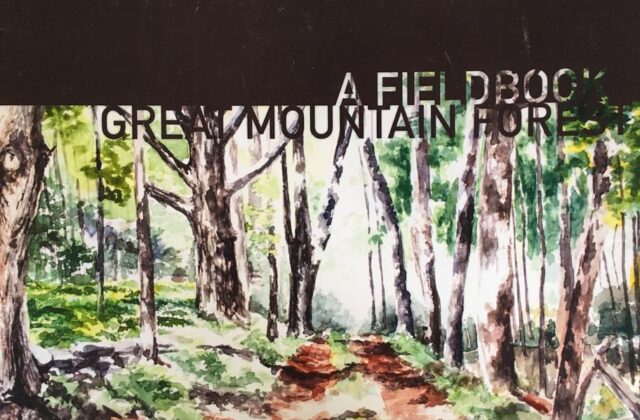A Field Guide Highlights the History and Beauty of Great Mountain Forest
By Mattie Vandiver
Norfolk’s Great Mountain Forest is a natural area full of hiking trails, wildlife, history, forestry and beauty. Those looking to find out more about the riches of GMF will enjoy an informative field guide published in 2016 under the auspices of the Yale Global Institute of Sustainable Forestry. Entitled “A Fieldbook: Great Mountain Forest,” the book was written by Michael Gaige and Yonatan Glogower. This book covers a wide range of topics about GMF, including its history, its natural resources and the scientific research conducted in the forest. In addition to the informative text, there are a number of captivating photographs throughout the book, as well as beautiful watercolor illustrations by Autumn Von Plinsky.
In the opening sections of “A Fieldbook” there are maps and graphs that present information on the geologic and geographic history of the forest, for example, the types of rock found in the area, topography, pollen percentages and forest types. The following section traces the human history of GMF, from the first people to live there 13,500 years ago to the settlement of Litchfield County; from the purchase of a piece of land by Starling W. Childs and Frederic C. Walcott in 1909 to Ted Child’s donation of land and funding for forestry research; and finally to GMF’s present-day programs and resources. This section ends with wonderful photographs of events over the years at GMF, including pictures of the 2015 GMF field day.
The next section of the field book highlights a few of the many interesting species that live in Great Mountain Forest—trees, plants and animals. These include red spruce, mountain laurel, oaks, birches, maples, hickories, moose, eastern newts, bears, beavers, and turkeys. One subsection is devoted to the American chestnut. The authors describe how in 1904 an airborne fungus that was introduced to the United States devastated the American chestnut population. In 2010, the American Chestnut Foundation planted on GMF land a plot of American chestnuts crossed with Chinese chestnuts in an effort to create a chestnut variety that would be more resistant to the blight.
A section called “Field Marks of Great Mountain Forest” describes the many markers on the GMF terrain, such as stone walls, cairns, charcoal hearths and fireplaces. A “field mark” is a feature that provides information about the history of habitation and other factors that have shaped the landscape. The book explains about the meaning of these marks, as well as where you can find them in the forest. There are also specific trees that are field marks, like coppiced trees and girdled pines. There are detailed descriptions and photographs of all the different kinds of field marks.
The section “Sites of Interest: Unique Natural Communities,” considers the many different ecological habitats of GMF. One such habitat is Tobey Bog. Tobey Bog has a unique ecology. For example, the wooden planks on the walkway are just sitting on top of the moss and water and are floating; they are not anchored to anything. Many unique species of plants grow and thrive in this habitat, including carnivorous plants such as sundews and pitcher plants.
The final sections of the field book track the history of land use, forest management and research sites at GMF. These sections are full of information about how GMF was used before it was the ecological site it is today. The book goes into detail, for example, about the charcoal hearths at GMF and where they can be found. The research section of the book describes many of the historical and current research sites at GMF. These include moose exclosures, genetics studies at the Yale pine and fir plantations and research on the carbon flux tower.
This field book captures the spirit that is at the heart of Great Mountain Forest by telling us about the people, wildlife, history, research, and stunning landscape that make up this forest today. As the authors write in the section on forest management, “The Great Mountain Forest is well known for its beautiful natural communities and the story of its human legacy, but it is also actively managed for a variety of economic, educational, and environmental objectives. Since the early days of Child and Walcott, GMF has striven to serve as a model for forest management that sustains and strengthens the integrity of the ecosystem, serving human stakeholders as well as plants and other creatures.”
“A Fieldbook: Great Mountain Forest” is available to download as a PDF. Go to greatmountainforest.org and click on “A Working Forest” and then “Research.”

